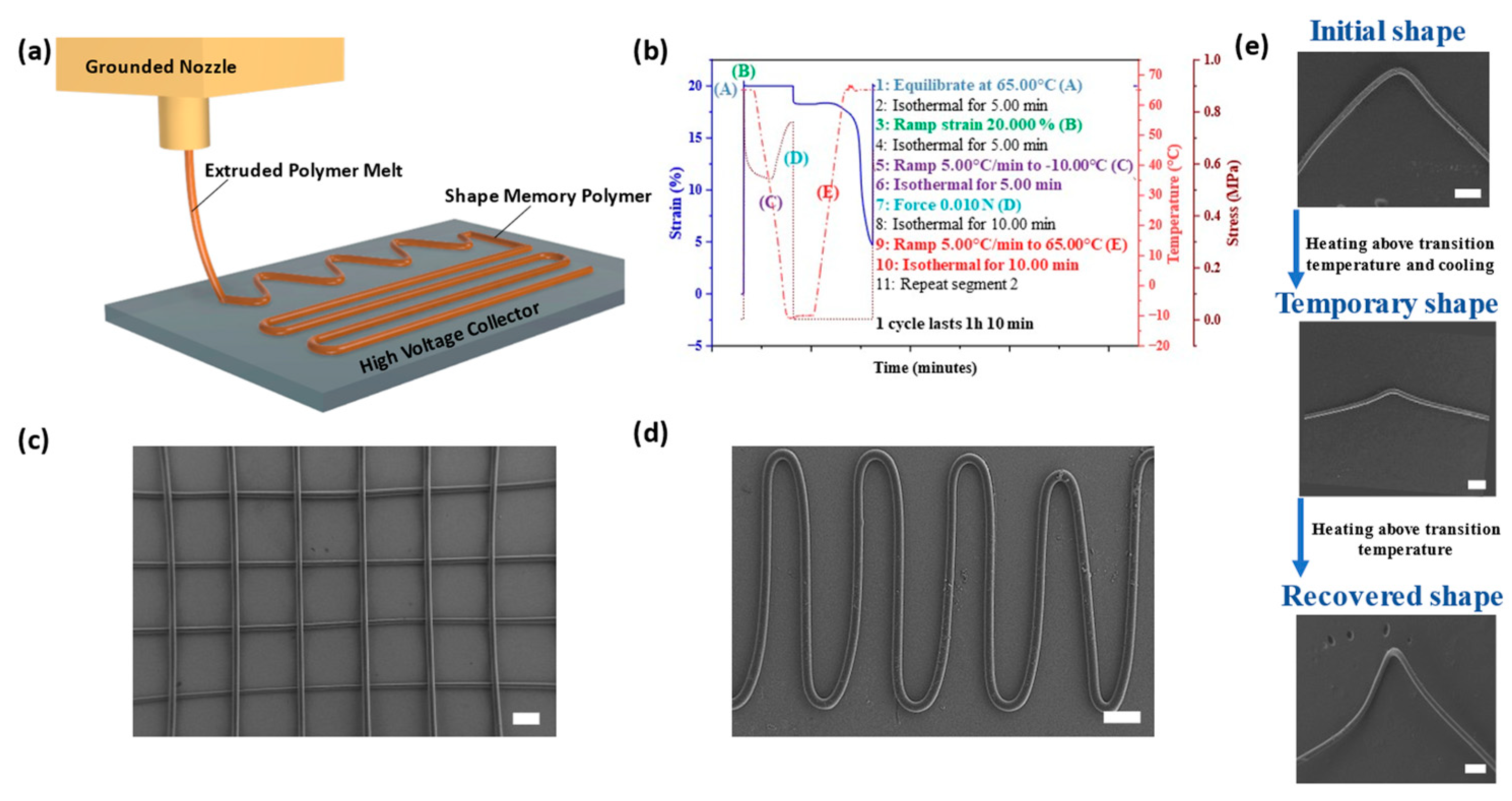Shape Memory Polymer Microstructures Using Melt Electrowriting †
Abstract
:1. Introduction
2. Materials and Methods
3. Discussion
Author Contributions
Funding
Institutional Review Board Statement
Informed Consent Statement
Data Availability Statement
Conflicts of Interest
References
- Kade, J.C.; Dalton, P.D. Polymers for Melt Electrowriting. Adv. Healthc. Mater. 2021, 10, 2001232. [Google Scholar] [CrossRef]
- Javadzadeh, M.; Del Barrio, J.; Sánchez-Somolinos, C.; Javadzadeh, M.; Sánchez-Somolinos, C.; Del Barrio, J. Melt Electrowriting of Liquid Crystal Elastomer Scaffolds with Programmed Mechanical Response. Adv. Mater. 2023, 35, 2209244. [Google Scholar] [CrossRef]
- Xia, Y.; He, Y.; Zhang, F.; Liu, Y.; Leng, J. A Review of Shape Memory Polymers and Composites: Mechanisms, Materials, and Applications. Adv. Mater. 2021, 33, 2000713. [Google Scholar] [CrossRef]
- Spiegel, C.A.; Hackner, M.; Bothe, V.P.; Spatz, J.P.; Blasco, E. 4D Printing of Shape Memory Polymers: From Macro to Micro. Adv. Funct. Mater. 2022, 32, 2110580. [Google Scholar] [CrossRef]
- Reizabal, A.; Kangur, T.; Saiz, P.G.; Menke, S.; Moser, C.; Brugger, J.; Dalton, P.D.; Luposchainsky, S. MEWron: An Open-Source Melt Electrowriting Platform. Addit. Manuf. 2023, 71, 103604. [Google Scholar] [CrossRef]
- Lee, H.T.; Kim, M.S.; Lee, G.Y.; Kim, C.S.; Ahn, S.H. Shape Memory Alloy (SMA)-Based Microscale Actuators with 60% Deformation Rate and 1.6 kHz Actuation Speed. Small 2018, 14, 1801023. [Google Scholar] [CrossRef]

Disclaimer/Publisher’s Note: The statements, opinions and data contained in all publications are solely those of the individual author(s) and contributor(s) and not of MDPI and/or the editor(s). MDPI and/or the editor(s) disclaim responsibility for any injury to people or property resulting from any ideas, methods, instructions or products referred to in the content. |
© 2024 by the authors. Licensee MDPI, Basel, Switzerland. This article is an open access article distributed under the terms and conditions of the Creative Commons Attribution (CC BY) license (https://creativecommons.org/licenses/by/4.0/).
Share and Cite
Tandon, B.; Sabahi, N.; Farsi, R.; Kangur, T.; Li, X.; Brugger, J. Shape Memory Polymer Microstructures Using Melt Electrowriting. Proceedings 2024, 97, 213. https://doi.org/10.3390/proceedings2024097213
Tandon B, Sabahi N, Farsi R, Kangur T, Li X, Brugger J. Shape Memory Polymer Microstructures Using Melt Electrowriting. Proceedings. 2024; 97(1):213. https://doi.org/10.3390/proceedings2024097213
Chicago/Turabian StyleTandon, Biranche, Nasim Sabahi, Reza Farsi, Taavet Kangur, Xiaopeng Li, and Jürgen Brugger. 2024. "Shape Memory Polymer Microstructures Using Melt Electrowriting" Proceedings 97, no. 1: 213. https://doi.org/10.3390/proceedings2024097213






